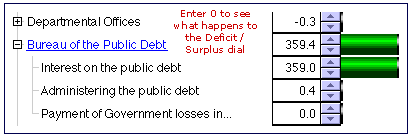Intro · Question · Rubric · Background · QuickQuest · Roles · Group · Conclusion · Help · Dictionary

Are you still angry? For sure you're informed! You and your teammates have learned a lot by dividing into four different roles and researching issues related to the U.S. federal budget. Now's the time to put your learning to the test. On this page, you'll work through a few different activities to help you decide what your group thinks about the U.S. budget in terms of allocations, deficits and surpluses.
First, as a whole team, you'll allocate general areas of the federal budget. Then, in pairs, you'll try one of two budget experiments before rejoining everyone in your group to write a persuasive essay that you'll send to your congressional representatives. Remember to check the Rubric to see how your group product can be assessed.
Both pairs will use the same Website: Budget Explorer. This site is a java applet that lets you change the amounts allocated to U.S. federal government departments and programs. Because it's a java applet, you must have java enabled on your browser. This is a cool app so we hope your browser is capable of using it. Note: actually loading a java applet takes some time so if you're working in a lab or on a slow connection, you might want to do this in advance.
Group Allocation of Major Budget Categories
The first activity is to actually allocate the federal budget. You'll answer the question: Where Does Your Money Go? You can do this one of two ways. You can check your knowledge of how money is spent or you can change the percentages according to how you believe they should be allocated. In other words, tell it like it is or change it to what you want it to be. Choose the one that best suits your learning goals. Either way, you'll follow the same procedures:
- Use the pulldown menus to select the percentage that you believe or want to be allocated to each category.
- When you've finished making changes, click on the link:
- The Budget Explorer will then give you feedback on how you carved up the budget pie. If you were testing how well you knew the real allocations, see how you closely you got. If you were choosing percentages based on what you wanted the amounts to be, use the feedback to see what areas of the budget you'll be trying to increase or decrease when it's your turn to adjust the actual budget amounts. After you've digested (or printed or saved) the feedback, click on the next link:

Paired Activity #1: The Fact Checkers and Budget Balancers
- If you aren't at the next step above of working with the Complete U.S. Federal Budget, go to the Budget Explorer and get to this step
- On this click you'll have to allow some time to load the applet and download the actual figures from the Federal Budget. Once the Budget Explorer applet is fully loaded, scroll down and click on "Bureau of the Public Debt" to expand the listing in that category.
What amount is set aside for interest? What is interest?
What is the unit? dollars? thousands of dollars, millions? billions, trillions?
What benefit do you think Americans get from this large expenditure?
- Watch what happens to the Deficit / Surplus dial if you reduce the interest level a little with the toggle down arrow.
Watch what happens to the Deficit / Surplus dial if you reduce the interest level to "0".How do you suppose everyone in America would come up with twenty grand to reduce the interest to zero? Would doing this help or hurt the economy?
Paired Activity #2: The Number Crunchers and the Growth Advocates
- Go to the Budget Explorer.
- Working together, look through the departments and programs that receive funding from the federal government. Notice that each of the blue links goes directly to the Web site for that Federal department or program. Depending on your time and interest, dig deeper into what some of the more costly or obscure areas are. This could take a minute to a week depending on what your group knows about U.S. government agencies.
- Discuss with your group members how you think the U.S. government should slice the budget money pie. Remember that compromise and give-and-take are a part of working together. This activity shouldn't create a war, but generate a good discussion and a shared vision. You might look for huge expenditures and trim them or find smaller programs to get rid of entirely. Decide, by agency name, which expenditures you will trim.
- See what happens to the budget if you start to increase and decrease areas based upon what your team feels is important.
- Keep at it until you either reach a balanced budget, reduce the deficit, or increase funding to areas that you think will increase the country's wealth (Gross Domestic Product).
When you've achieved a set of allocations that your team believes in, click the link labeled "Next: Results of your changes." If this is the way your group believes the world of the U.S. Federal Budget should be, you can save your results by choosing "File: Save As...". A nice thing is to save the file as HTML source so you can get the pie charts displayed.
Coming to a Group Answer
Use the results from your budget simulation, your notes, re-surf the sites for your role, or use the Hotlist of Links to answer the following questions as a group:
- Is having a $5 trillion national debt a problem?
- What should your U.S. government representatives do about this situation?
Discuss these questions until all team members feel they have had a chance to offer their viewpoints. It's time to put your opinions, fresh ideas, and evidence into a persuasive essay. You can go about this the best you see fit. For some, you'll understand this task and be on your way brainstorming, drafting, researching, getting feedback, revising, etc. Others who aren't so experienced writing persuasive essays may want a little more support and scaffolding. If this is the case, we've put together a little javascript to help you quickly format a persuasive thesis statement and the barebones of a traditional five paragraph essay outline. If you're interested, try the Thesis Maker. If you know what to do on your own or with someone's help, go for it.
If you and your team are writing the essay, make it part of the job that everyone must contribute. Each person might write a body paragraph (with researched evidence) or maybe each person writes their own essay, then everyone helps edit. You can decide.
Real World Feedback
It would be nice is this dilemma of the national debt were just a school problem. It could save you lots or money and uncertainty. Unfortunately it's a real situation so instead of sticking our heads in the sand, we'll stick out our necks and make our opinions known to the world. Any why not to the people who were sent to Washington to represent the citizens of your neighborhood?
Once you have a well-researched, communicated, and edited essay that's interesting to read, send it into the real world. Use one of the links below (or another approach) to make contact. Take the course of action that you think will be most effective.
- Contacting Congress
- background and contact information on congressional representatives
- All Politics Congress and Governor Guide
- contact information and Web site links
- Contact information for U.S. Senators
- access to official Web pages and email addresses
- Mr. Smith Goes to Washington
- a tool for emailing your essay to many people at once
Where do You Go from Here?
After these "Group Process" and Real world Feedback phases of the WebQuest, you're almost finished! Take a look at the Rubric one last time, then more on to the Conclusion.
|
Created May, 1996. Last revised February, 2005 by Tom March, Applications Design Team/Wired Learning http://www.kn.pacbell.com/wired/democracy/group.html Copyright © 1996 - 2005 SBC Communications -- All Rights Reserved |



